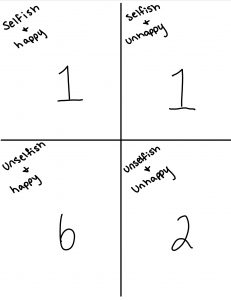Artifact 5:
For my last favorite archive, I chose the Module 8 Archive. For this artifact, we had to pick two adjectives that we thought were common stereotypes to describe each ethnic group. A list of adjectives and ethnic groups were given to us. At the end, we had to compare our results to the findings done by Katz and Braly in 1933 and Gilbert in 1951. I found it really interesting to see how stereotypes changed over time. I agreed that I thought the stereotypes were becoming more positive for minority groups because their positions in society have been changing. Minority groups are beginning to have a lot more positions in government and higher positions in society. It took way too long for our country to begin getting there, but I think we are on the road to change.
Representative Visual Image:
I chose this image because it shows a few of the adjectives I chose, along with the adjectives that came from the studies done by Katz and Braly and the study done by Gilbert. It is interesting to look at this word cloud and decipher what is still true today when it comes to stereotypes around Americans.
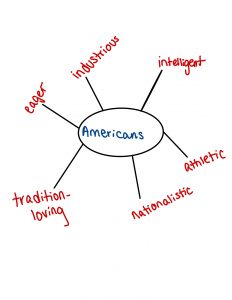
Artifact 4:
I found the Module 4 Archive to be interesting because it was all about how news outlets can blow things out of proportion to instill fear into people. This archive asked us to watch a Ted Talk that focused on biased media coverage and how the news tries to scare people. Then, we had to identify something in the news that has been overemphasized as well as describe how reports of terrorism on the news can lead people to a distorted view of average people in the terrorists’ home countries. I wrote about the Covid-19 pandemic and how the news outlets were reporting the scariest possible stories regarding the virus. The virus is a scary thing and has taken a lot of lives, but I personally found it to be really depressing to hear and see that everywhere I looked on social media. I feel like reporting positive things is more beneficial than only reporting the negatives. Since the vaccine has been out, it has been nice to see a few more positive news stories, rather than traumatic ones.
Representative Visual Image:
I chose this image because I thought this part of the Ted Talk was very interesting because it brought to light how we often focus more on things that are less likely to kill or injure us. This could be a result of how the news outlets often report all the negative stories and no positive ones.
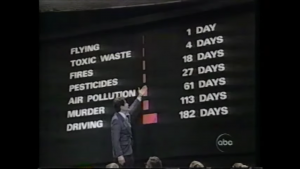
Artifact 3:
Module 10 Archive was another fun experience to do. For this archive, we were asked to pay attention to a certain thing people do in public that is against regular social norms. With Covid-19 being so relevant right now, I decided to focus on people who were not wearing masks in public. I won’t judge someone for not wearing a mask in public unless they are being downright disrespectful and getting too close to people. I try to keep in mind that someone might have a condition like asthma, and are unable to wear a mask for long periods of time. It was interesting to actually pay attention to who was or wasn’t wearing masks when going into a store. The majority of people were wearing masks, but I remember seeing one person who wasn’t. I didn’t witness any negative comments being made towards or about the person, but I see a lot of ridicule regarding non-mask wearers on social media.
Representative Visual Image:
I chose this image because it is interesting to see how masks have been worked into being a norm. Usually a public place may have a “No shirt, No shoes, No service” sign on their door, but now “No mask” is included as well.
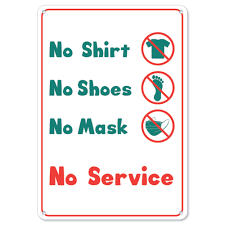
Artifact 2:
I am choosing Module 3 Archive as one of my top archives because of how much I enjoyed doing this one. For this archive, we were asked to recruit a few people for a short questionnaire. You either asked the people about the saying “similarity leads to attraction” or about the saying “opposites attract”. I chose two people for each saying. It was interesting because the people I asked all agreed that the saying I asked them about was true. If they would have heard both of the sayings, they might have agreed with one more over the other. It was interesting how they were able to come up with reasons why the saying could be true. I enjoyed having the conversations with them, and then hearing what they thought about the other saying once they backed up the first one. Most of them agreed that it could go both ways after hearing both sayings.
Representative Visual Image:
I chose this image because it shows my results and notes taken from the questionnaire. It helps you see what each person said and it is interesting to see how people interpret the sayings differently. They each had different, but similar, reasons behind backing up the sayings.
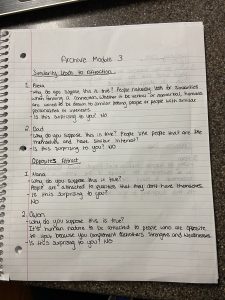
Artifact 1:
The Module 11 Archive was my favorite because it was pretty relevant in my life at the time I did it. In this archive we had to write the initials of ten different people we know well and put whether they are unhappy or happy and whether they are selfish or unselfish. It was really interesting to see the correlation between being both happy and unselfish. I was having issues with someone in my life at the time and I started to realize that them being mean and selfish stemmed from their own personal unhappiness. After doing this assignment, I noticed that the majority of people who were happy were also matched up with being unselfish. When people are happy with their own lives, they are usually more willing to do things for others and build other people up. Unhappy people can sometimes spread negativity on others just from not being happy with their life.
Representative Visual Image:
I chose this image because it shows the results of the ten people I chose to rate whether they are happy or unhappy and selfish or unselfish. It is really interesting to see how the majority of people were unselfish and happy.
